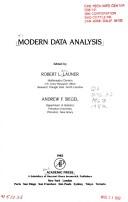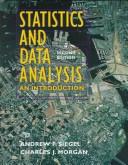| Listing 1 - 10 of 12 | << page >> |
Sort by
|
Book
ISBN: 0471876593 9780471876595 0471876607 9780471876601 047189186X 9780471891864 Year: 1988 Publisher: New York J. Wiley
Abstract | Keywords | Export | Availability | Bookmark
 Loading...
Loading...Choose an application
- Reference Manager
- EndNote
- RefWorks (Direct export to RefWorks)
Statistics. --- Statistique --- Statistical analysis --- Statistical data --- Statistical methods --- Statistical science --- Mathematics --- Econometrics --- Statistics
Book
ISBN: 0534055680 0412989018 9780534055684 Year: 1986 Publisher: New York Chapman & Hall
Abstract | Keywords | Export | Availability | Bookmark
 Loading...
Loading...Choose an application
- Reference Manager
- EndNote
- RefWorks (Direct export to RefWorks)
Probability theory --- Stochastic processes --- Probabilities --- Mathematical statistics --- Probabilités --- Statistique mathématique --- 519.2 --- Probability --- Statistical inference --- Combinations --- Mathematics --- Chance --- Least squares --- Risk --- Statistics, Mathematical --- Statistics --- Sampling (Statistics) --- Probability. Mathematical statistics --- Statistical methods --- 519.2 Probability. Mathematical statistics --- Probabilités --- Statistique mathématique

ISBN: 0124381804 132255949X 1483263061 Year: 1982 Publisher: New York (N.Y.): Academic press
Abstract | Keywords | Export | Availability | Bookmark
 Loading...
Loading...Choose an application
- Reference Manager
- EndNote
- RefWorks (Direct export to RefWorks)
Mathematical statistics --- -681.3*A0 --- 681.3*I0 --- 681.3*I3 --- Mathematics --- Statistical inference --- Statistics, Mathematical --- Statistics --- Probabilities --- Sampling (Statistics) --- Congresses --- General --- Computerwetenschap--?*I0 --- Computer graphics (Computing methodologies) --- Statistical methods --- 681.3*I3 Computer graphics (Computing methodologies) --- 681.3*A0 General --- 681.3*A0

ISBN: 0471574244 Year: 1996 Publisher: New York Wiley
Abstract | Keywords | Export | Availability | Bookmark
 Loading...
Loading...Choose an application
- Reference Manager
- EndNote
- RefWorks (Direct export to RefWorks)
Digital
Abstract | Keywords | Export | Availability | Bookmark
 Loading...
Loading...Choose an application
- Reference Manager
- EndNote
- RefWorks (Direct export to RefWorks)
Digital
Abstract | Keywords | Export | Availability | Bookmark
 Loading...
Loading...Choose an application
- Reference Manager
- EndNote
- RefWorks (Direct export to RefWorks)
Digital
Year: 2005 Publisher: Cambridge, Mass. NBER
Abstract | Keywords | Export | Availability | Bookmark
 Loading...
Loading...Choose an application
- Reference Manager
- EndNote
- RefWorks (Direct export to RefWorks)
Book
Year: 1985 Publisher: Cambridge, Mass.: National Bureau of Economic Research
Abstract | Keywords | Export | Availability | Bookmark
 Loading...
Loading...Choose an application
- Reference Manager
- EndNote
- RefWorks (Direct export to RefWorks)
Book
Year: 1985 Publisher: Cambridge, Mass. National Bureau of Economic Research
Abstract | Keywords | Export | Availability | Bookmark
 Loading...
Loading...Choose an application
- Reference Manager
- EndNote
- RefWorks (Direct export to RefWorks)
A new model is proposed for representinq the term to maturity structure of interest rates at a point in time.The model produces humped, monotonic and S-shaped yield curves using four parameters. Conditional on a time decay parameter, estimates of the other three are obtained by least squares. Yield curves for thirty-seven sets of U.S. Treasury bill yields with maturities up to one year are presented. The median standard deviation of fit is just over seven basis points and the corresponding median R-squared is .96. Study of residuals suggests the existence of specific maturity effects not previously identified. Using the models to predict the price of a long term bond provides a diagnostic check and suggests directions for further research.
Book
Year: 2006 Publisher: Cambridge, Mass. National Bureau of Economic Research
Abstract | Keywords | Export | Availability | Bookmark
 Loading...
Loading...Choose an application
- Reference Manager
- EndNote
- RefWorks (Direct export to RefWorks)
We develop asset pricing models' implications for portfolio efficiency when there is conditioning information in the form of a set of lagged instruments. A model of expected returns identifies a portfolio that should be minimum variance efficient with respect to the conditioning information. Our tests refine previous tests of portfolio efficiency, using the conditioning information optimally. We reject the efficiency of all static or time-varying combinations of the three Fama-French (1996) factors with respect to the conditioning information and also the conditional efficiency of time-varying combinations of the factors, given standard lagged instruments.
| Listing 1 - 10 of 12 | << page >> |
Sort by
|

 Search
Search Feedback
Feedback About UniCat
About UniCat  Help
Help News
News